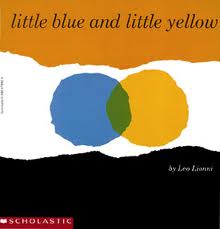One of the books I chose for this
activity is called: The Skin You Live In. Written by: Michael Tyler. This book
is about children who are different skin colors, and that Is ok. It is an
important message of social acceptance of young children, friendship, and self
esteem. The book has rhythm and the pages are very colorful. I felt this book
was appropriate because it is important for children to be comfortable with
their skin color, and who they are.
Another book I
chose is called: Little Blue, Little Yellow. By Leo Lionni. This is the story of two best friends: little
blue and little yellow. They go to school and play everyday until one day they
can't find each other. Finally, they reunite and the two friends hug until
little blue and little yellow both become little greens! They go home and are
rejected by their parents who do not recognize their own children! Not wanted
in their own homes little blue and little yellow meet again and cry. Their
tears change little blue and little yellow back to their original colors.
Little blue speeds off to explain everything to his parents who are so
overjoyed that they go running across the street to tell little yellow's
parents. Then their parents end up hugging until they themselves turn green.
This is appropriate because it is important for children to know early about
the color of their skin, and other people’s skin color, so they don’t grow up
being curious, or making fun of others.
It’s Me! The theme is the children’s bodies, and class. To
recognize and celebrate one’s own physical features, and beauty, experience
dignity and pride. You need small unbreakable mirrors, skin color paints,
markers, or crayons, construction or drawing paper. Invite children to look at
themselves in the mirror, help them notice and name their physical features,
for instance, “your hair is brown, curly, and short. Your eyes are brown and
round” encourage children to draw or paint a self portrait; encourage them to
continually refer back to their mirrors if they forget what their face looks
like. Ask each child to share his or her pictures at group time. Using larger
unbreakable mirrors, invite children to draw their face on the mirror.
Self-Portrait
Bodies, our class, recognize and celebrate ones own physical
features, recognize ones own beauty, experience dignity and pride. Photograph
of each child, a color enlargement of each photo, a plexiglass easel or clear
acetate, skin color paints, a variety of other colors of paint, paint brushes,
smocks. Take a picture of each child’s face. Enlarge the photograph on a color
copy machine. Lay it on the table and put a piece of clear acetate over it, or
tape it to the back of a clear plexiglass easel. Invite mirrors. Encourage the
child to compare and contrast their face in the mirror with the photograph and
their self portrait.
Draw me/Draw you
I’m me and I’m special, friends, alike and different, five
senses. Appreciate the beauty and value of others. Appreciate the physical
characteristics of others. Experience positive, respectful interactions with
people who are different. Drawing paper, felt tip pens, crayons. Have the
children find a partner and ask them to sit across from one another at the
table. Encourage the children to draw a picture of their partners face. Ask
them to look at their partner. Then ask “what color is his skin? What color are
her eyes? Does he have freckles? What color is her hair? How long is his hair?
Is her hair straight or curly?” the drawing probably wont look like the
partner. That’s all right. Looking at the features of another person is the
important part. Ask the children to exchange the drawings when they are done.
1. Have the children describe themselves to each other before they begin
drawing. 2. Have the children share their drawings with the class at group
time. 3. Play a guessing game during group time. Have the children look at the
drawing and guess who it is.
I chose an activity that I titled “Chalk Me”. For this you need chalk, kids, and sidewalk! Having a bunch of color chalk, asking the children to grab the color chalk they think their skin color is. The child hands that color to their partner and the other child lays on the ground, while the child with the chalk begins to trace the child laying down. I felt this would be a good idea for children, because they are choosing the color they think their skin color is. On page 42 (York York
I chose an activity that I titled “Chalk Me”. For this you need chalk, kids, and sidewalk! Having a bunch of color chalk, asking the children to grab the color chalk they think their skin color is. The child hands that color to their partner and the other child lays on the ground, while the child with the chalk begins to trace the child laying down. I felt this would be a good idea for children, because they are choosing the color they think their skin color is. On page 42 (
When I asked a
child to pick their color of skin from chalk, he grabbed the white one. I asked
why he grabbed the while one and he said “because I’m white”. It made me think
on the video we watched in class a while back about how children will just
chose brown, or black or white, instead of peach, or Carmel





